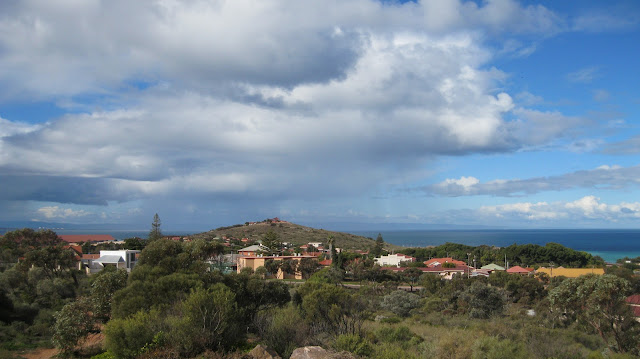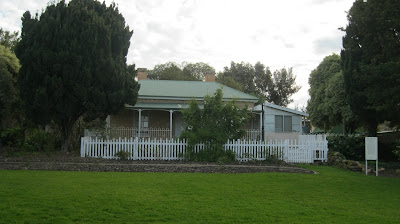Sunday 22nd July
A beautiful sunrise was ours for the taking this morning, so
we surprised ourselves by being ready and out on the road by just after 9
am. Our first stop was the Old Mill
again so that I could be confident in my climb – yes I did it without any worries today. As
I mentioned before the grain silos and the jetty are blots on the seascape,
however the view from the mill was quite good.
The
next stop was named Winters Hill and here we enjoyed a vista of both the ocean
and the countryside behind this hill.
We could just make out the slight yellow
haze of canola which is nearly ready to bloom. A man was just leaving this lookout
as we arrived, but a few minutes later he drove back to tell us about Sleaford
Bay, about 15km away and a place where whales have been sighted recently. We found out he is an abalone diver and he
was happy to answer my questions about the industry. He only works about 50 days a year as there
is a quota of abalone which can be caught and after that they wait for the next
year. We did drive out to Sleaford Bay to join a few other people who were on
the same mission, but alas the whales were otherwise occupied today and not out
to entertain us.

We
had been given a recommendation of a place to get the “best fish and chips in
Port Lincoln”, so down to the Marina we headed to find the Coastal Café. We left our platters clean after a delicious
fish, chips and salad lunch – the owner came to tell us that he has a source of
fresh fish here and that is all he uses – no frozen fish at all. This was refreshing to know as on many
occasions we are lured to a spot as it is the place where something is grown,
or farmed, only to find there is a shop selling souvenirs of the said
industry. I want to be at the coal face,
not just look at souvenirs or photos!!
Close
by we paused at the Fisherman’s Memorial, created in honour of all the fishermen
who have never returned from their seafaring. One can see the mother and children looking out to sea. It was crafted by Marijan Bekic, the same person who made the Farmer
statue in Wudinna which we saw about a week ago.
One
of the brochures from yesterday was about a Segway track at Glen-Forest Tourist
Park and vineyard at Greenpatch about 20km from the city. This sounded like
something different and a way to work off the fish and chips, so we headed out
there to be greeted by many species of wildlife including kangaroo, peacock,
emu, ostrich, alpacas and many others.
Kym the owner took us on a 45 minute trip on
the segway which was a whole lot of fun.
The idea is to lean your body toward the handlebars to gain speed and
bend the knees, and to stop you need to almost stand up straight. Apart from two minor spills we hooned all
over his farm and paddocks, scaring a flock of sheep in the process and
generally just having a great time. Yes even
old grey nomads can do this – I would recommend it to anyone as its very easy
to pick up.
Our
final destination today was the Axel Stenross Maritime
Museum featuring older style tools used in building wooden boats, wooden
dinghies, large collection of maritime artifacts and photos as well as newspaper
cuttings of the local fishing and boating history. The museum was named in honour of Axel Stenross,
a Finnish fisherman who made Port Lincoln his home. There was a poignant story about the fiancée whom
he had left in Finland. He wrote to her
after being in Port Lincoln for a few years telling her that she would not be
able to cope with the lifestyle out here and that it was best to call off the
engagement. She never married, looked
after her elderly parents and it was only after her death that Axel married a
lady from Port Lincoln whom he had been courting for 30 years. They had 17 years of marriage and he outlived
her by about 5 years.
















































